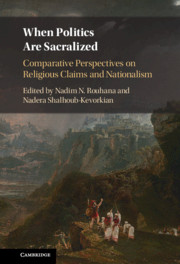Book contents
- When Politics Are Sacralized
- When Politics Are Sacralized
- Copyright page
- Contents
- Figures
- Maps
- Tables
- Contributors
- Preface and Acknowledgments
- 1 A Comparative Perspective on Religious Claims and Sacralized Politics
- Part I Israel
- Part II India
- Part III Sri Lanka
- Part IV Serbia
- Part V Iran
- Part VI Saudi Arabia and Wahhabism
- Part VII Northern Ireland
- 12 Protestantism and Settler Identity
- 13 Does Religion Still Matter?
- Part VIII Palestine
- Index
- References
13 - Does Religion Still Matter?
Comparative Lessons from the Ethno-national Conflict in Northern Ireland
from Part VII - Northern Ireland
Published online by Cambridge University Press: 10 June 2021
- When Politics Are Sacralized
- When Politics Are Sacralized
- Copyright page
- Contents
- Figures
- Maps
- Tables
- Contributors
- Preface and Acknowledgments
- 1 A Comparative Perspective on Religious Claims and Sacralized Politics
- Part I Israel
- Part II India
- Part III Sri Lanka
- Part IV Serbia
- Part V Iran
- Part VI Saudi Arabia and Wahhabism
- Part VII Northern Ireland
- 12 Protestantism and Settler Identity
- 13 Does Religion Still Matter?
- Part VIII Palestine
- Index
- References
Summary
This chapter explores the enduring intersections of popular religion, violence, and ethno-national memory in Belfast. Wider debates on the nexus between religion, violence, and politics are integrated with recent empirical data on the contemporary post-conflict city. The chapter demonstrates how conflicting narratives of nationalism, imperialism, and popular religion materialize in the “sacred spaces,” public rituals, and territorial enclosures of a nominally secular city located historically in the heartlands of Western imperialism.
Keywords
- Type
- Chapter
- Information
- When Politics are SacralizedComparative Perspectives on Religious Claims and Nationalism, pp. 337 - 362Publisher: Cambridge University PressPrint publication year: 2021
References
- 4
- Cited by



